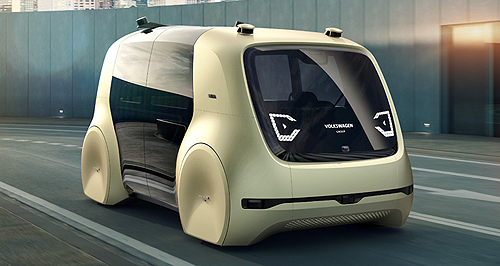Geneva show: VW ditches the driver with Sedric
BY RON HAMMERTON | 8th Mar 2017

Promising 30 more battery powered production vehicles by 2025, VW says the four-seat all-electric Sedric – standing for self-driving car – was developed from scratch to provide a concrete insight into autonomous driving at the highest level.
While most autonomous prototypes developed to date still have steering wheels and pedals for emergencies, the Sedric has neither, meaning it is designed as a Level 5 autonomous vehicle, capable of shuttling passengers to their destination without human input and under all driving conditions.
It could operate as a ride-sharing vehicle or as personal transport capable of taking the kids to school or running errands such as collecting shopping from the store.
The Sedric can head off to find its own parking and then be summoned by a push or a button or smartphone, arriving at a destination for passenger pick up at a predetermined time.
Described as a lounge on wheels, the 2+2 Sedric has wide-opening swing doors similar to those on a subway train or tram for easy access, as well as ample cabin space between the facing seats for luggage, like a London black cab.
Revealed by VW CEO Matthias Mueller on the eve of the annual Geneva motor show, the car is a cross-brands platform, meaning it could be applied across the Volkswagen Group’s 12 marques that, apart from VW, are likely to include Skoda, Seat, Audi and even Porsche and Lamborghini.
The company describes the Sedric as an “ideas platform” and “the father” of a proposed family of self-driving vehicles across these brands.
“Soon Sedric will also get ‘children’ and ‘grandchildren’ with the group's various brands,” VW said in its press release.
“They will be created in typical designs for the brands and will feature tailor-made and customer-specific characteristics for equipment.” Mr Mueller said VW was convinced that fully-automated vehicles would make life in cities better, more eco-friendly and safer.
“The future of mobility is vibrant, colourful and fascinating,” he said. “With Sedric we are looking far ahead: the study demonstrates how a new, integrated mobility system of the future could function.” The Sedric – not to be confused with the old 1960s Nissan Cedric that was named after the lead character in Little Lord Fauntleroy by a Nissan CEO besotted by such British shows - was developed jointly by VW’s Future Centre Europe in Potsdam and Volkswagen Group Research in Wolfsburg.
The design group said a key to Sedric’s design was simplicity of operation that was required to be “completely intuitive”, and almost human-like in its interaction with passengers.
“When a passenger gets into the car, they can talk to Sedric,” VW says. “Passengers can talk to Sedric about the destination, how to get there, the driving time, the current traffic situation, perhaps even a short break on the way.
“Users can talk to Sedric like they would with a personal assistant. While you are on the road, you can choose exactly what you want to do.
“The windscreen is a big OLED screen with augmented reality serves as a communication and entertainment centre – but passengers can also close their eyes, sit back and relax.” When collecting passengers, Sedric can recognise its owner as he or she approaches and open the doors automatically.
VW says it has 37 “competence centres and digital labs” around the world working on future technologies under its Together – Strategy 2025 plan for e-mobility.